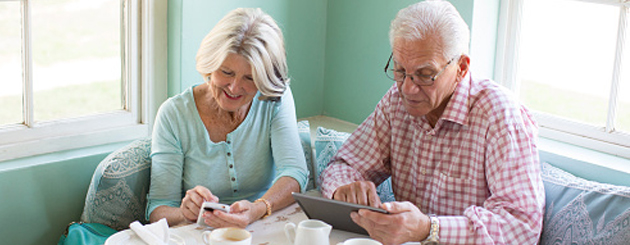
By Rex Hammock, CEO
You’ve seen them. They appear in
“Saturday Night Live” skits and
insurance commercials. They are cliches of a misdirected belief that most older individuals are clueless when it comes to technology ownership and usage.
However, according to recent research, including studies from Google, AARP and the Pew Research Center, the reality is that older adults are buying, using and mastering:
- Smartphones
- Home assistant technology (such as Amazon’s Echo)
- Wearable technology (including smartwatches)
- Tablets (such as iPads)
Google calls these tech buyers and users “digital seniors.”
In reality, people in their 60s and 70s are buying more technology—and more know how to use it.
- Older adults (70+) have a particular fondness for tablets, with more than half (53%) owning one—an increase from 40% in 2019.
- These tablets aren’t just sitting on a coffee table gathering dust: 69% said they use their tablets daily.
- Older adults are spending (on average) $1,144 on tech, up from $394 in 2019.
The top three tech purchases are smartphones, smart TVs and Bluetooth headsets/earbuds.
A majority of seniors spend at least
six hours a day online and own an average of five devices.
“Digital seniors” go online for a vast array of reasons:
91% | Staying in touch with friends and family
87% | Organizing their finances
73% | Improving their health and wellness
They aren’t just a temporary reaction to COVID-19:
70% | Say in surveys that they’ll still spend the same amount or more time online once they’re no longer concerned about the pandemic.
What marketers should learn from this new research of digital seniors:
Rather than making fun of one of the fastest-growing tech purchasing segments, here are three suggestions from Google’s Kelly Twohig (industry director, Healthcare).
- Understand your consumer with data and insights, not outmoded assumptions and hunches.
- Meet your audience where they are. As we’ve seen, YouTube plays a crucial role in seniors’ lives. Increase your investment where they’re increasing their time to build awareness and consideration.
- Prioritize high-value audiences, rather than broad ones. Use the rich set of intent signals available on YouTube (in-market, newly retired, similar audiences, location) to reach your most valuable consumers at scale.
Photo: Getty Images
About Hammock Healthcare Idea Email | This post is part of Hammock’s award-winning Idea Email series. Idea Emails are sent every other week and share one insightful marketing idea. Idea Email comes in two flavors: Original and Healthcare. To subscribe to the original Idea Email (general marketing ideas), click here . To subscribe to the Healthcare Idea Email (healthcare marketing ideas), click here.



